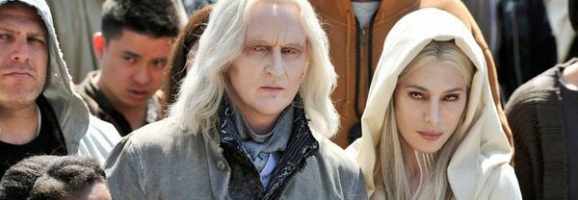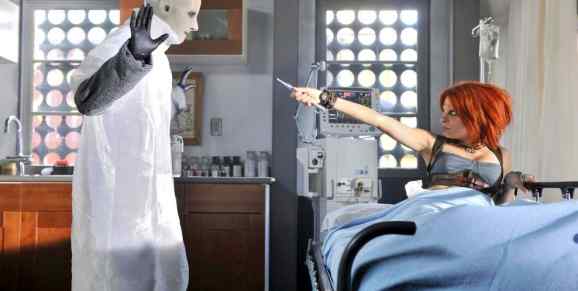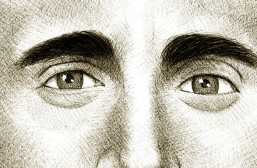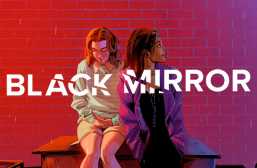Cultural Commentary and Genre in ‘Defiance’

The sci-fi and western hybrid series Defiance, having recently wrapped its first season on Syfy network in the US (and confirmed for a second), leverages facets of both genres to explore sensitive contemporary issues. Through the frame of human/alien interaction, it explores the complexities of differing cultures living side-by-side. Replacing known cultural groups with humanoid extra-terrestrials – ethereal, Legolas-like Castithans, the scaled and silver-blooded Indogene, and what are basically over-sized orangutans – diminishes pre-existing concepts of race and culture, giving the show’s writers a ‘clean slate’ to explore some challenging themes.
In this way it’s reminiscent of the 2009 film District 9 which depicted a mass of insect-like aliens stranded in a ghetto in Johannesburg. To engender a sense of reality, director Neill Blomkamp included interviews with real people and their confronting opinions towards actual refugees living in Johannesburg’s ghettos.
Defiance explores the challenges faced by (in this case, burgeoning) pluralist societies. It does this using various humanoid alien races, referred to collectively as the Votan, stranded on earth after fleeing their destroyed solar system. Of the various cultural groups, the Irathients – the most ‘outsider’ of the Votan races – experience a higher degree of prejudice from both fellow Votans and humans: from racial slurs to acts of violence.
This is evident in the ninth episode If Ever I Leave This World Alive, in which Irathients are presumed to be the vectors of a disease deadly only to humans. Subsequently, the Irathients experience a storm of racial abuse. They’re labelled unhygienic and likened to rats, and then imprisoned in a mining tunnel – an act rendered redundant as the group was already quarantined in their remote encampment. Finally, while imprisoned in the tunnels, an Irathient is shot for refusing to cease a traditional dance. This episode encourages us to view discrimination as unnecessary and destructive. It highlights the existence of choice: it’s not necessary to treat the Irathients in this manner. It also explores the idea that by characterising a group as inhuman, savage and unclean, then treating them as such; the group is given no choice other than to act in this manner ascribed to them.
Cultural conflicts also arise in the second episode, Down to the Ground Where the Dead Men Go, in which a Castithan willingly participates in a ‘cleansing ritual’ which, to an Irathient observer, more closely resembles torture. The episode proceeds to negotiate the point at which law should intercede in matters of cultural practice; mirroring a number of similar modern narratives, such as female circumcision.
Defiance also leverages western genre conventions to explore cultural friction. For example, episode three, The Devil in the Dark, employs the traditionally-western binary of homesteader/rancher to explore the story of a family of Iratheint subsistence farmers, murdered for their land by a ruthless mining company. With the subtraction of red-headed aliens and the addition of buckskin-and-chambray, his storyline could be lifted from George Stevens’ 1953 western Shane – both texts similarly explore the struggles of homesteaders against cattle ranchers as a powerful ‘other’.

In the western tradition, Defiance looks at colonialism in terms of East-v-West and territory-v-federation binaries. The inter-species government based in New York known as the Earth Republic represents the genre’s East: offering order, safety and civilisation, with a hint of corruption and demands of subservience. The township of ‘Defiance’, which gives the show its name, represents the genre’s West: characterised as savage, chaotic and primitive, but also authentic and free. The Defiance/Earth Republic relationship mirrors the relationship between territories and the United States seen in traditional westerns, symptomatic of the United States’ sometimes uneasy relationship with federation.
Another common colonisation binary in westerns is that of the Native American/European or native/introduced. Votan races are represented as exotic, displaced people whose cultural practices are not always understood by humans and/or fellow Votans (often both). The Irathients in particular are endowed with a mystical quality, some possessing supernatural abilities. In this way, Votans, and specifically the Irathients, serve a similar role to that of Native Americans in westerns. This said, humans – quite literally the native inhabitants of Earth – operate alternatively in this role.
But the western genre does not have a monopoly on exploring these themes – as a genre, sci-fi often deals with the theme of colonisation, usually in the guise of humans or aliens colonising (often inhabited) planets. The ultimate act of colonisation takes place in Defiance as the earth itself is terraformed by alien technology, reminiscent of the European’s transformation of the new world through agricultural practices and the introduction of exotic species as represented in Westerns. In many countries, the implications of colonisation are still at the forefront of public consciousness, and once again, by stripping away cultural preconceptions, western and sci-fi genres allow a conversation to take place in abstraction.
By leveraging facets of western and sci-fi genres, Defiance explores sensitive contemporary issues of colonisation and pluralism. Through the sci-fi specific device of ‘aliens’, the complexities of pluralist cultures are explored, while western genre binaries are correspondingly used to explore cultural conflict and the implications of colonisation. Wrapping these themes in genre makes them more accessible, ensuring a larger audience than if the text simply depicted modern instances of cultural friction and colonialist fallout. In this way, the fantasy of sci-fi and western genres makes difficult, challenging or off-putting concepts more palatable, enabling writers to engage a casual audience – a ‘spoon full of sugar’ to complement grim cultural commentary.
What do you think? Leave a comment.











Syfy has somehow managed to drain all the Scifi out of what used to be a promising show. The plot and even much the dialog seem to be lifted from a ‘Bonanza’ or ‘Gunsmoke’ episode out of the sixties.
The show has become a soap opera into which the writers are dumping every cliché there is. There is no more Scifi here- only hidden agendas, backstabbing, murders, politics, moles and spies plotting against the town, betrayals, angry (and murderous) racist mobs of townspeople blaming the innocent Indians, sorry- the Irathients… I don’t know what to say. Disappointment.
Now with all of that being said, the depth of this article was great and very interesting to read. Makes me almost continue to watch it -almost.
Thanks for sharing your thoughts :). Sorry to hear you haven’t enjoyed ‘Defiance’. It is heavy on the western.
I also think the whole backstabbingy, murdey politics element you’ve identified may be linked to a pressure to produce another ‘Game of Thrones’. If Cersei Lannister replaced Stahma Tarr next season I could watch an episode or two before noticing the ruse.
It reminds me of Farscape. The first couple shows I didn’t really know what was going on but it developed into a real passion. I can see that happening with Defiance. Give it another season I say.
It definitely reminds me of Firefly (which is objectively great). Thanks for the comment!
Enjoyed reading this post! I admit I didn’t have high hopes for this series. With it’s Mad Max meets Alien Nation premise I feared the worst. But it is decent thus far.
The series scores a home-run by creating a unique language for the aliens. Then there’s the matter of the show foolishly assuming that money exists in the future, or some form of monetary economics will be practiced. Defiance seems an ideal town for a money system, but factions like the Earth Republic has no use whatsoever for a mundane and archaic money system.
Hi Cammie, that’s an interesting perspective. I hadn’t really considered the currency.
I suppose I would have thought quite the opposite – that a smaller society (i.e Defiance) would be better able to implement a barter system, or some other non-money related system of exchange. The Republic, however, being a larger group, comprised of smaller geographically isolated subgroups, would benefit from some kind of currency to facilitate trade – especially considering the internet’s not a thing.
Are there other systems that would work better/would more likely organically occur? I’m keen to know 🙂
Really interesting article Rebecca.
Science fiction has a tradition of adapting western mythologies? Gene Roddenberry famously pitched Star Trek as Wagon Train to the stars and Joss Whedon’s Firefly was inspired by The Killer Angels and post US civil war expansion into the western territories.
Now if Defiance gets into some Deadwood themes, I’ll be really interested. Is there a Castithan word for cocksucker?
Yes! Deadwood is the best! An alien Calamity Jane would be winsome.
Great article! Western and sic-fi intricacies have mixed sine the dawn of cinema. Both genres reach out the masses by containing similar iconic elements whilst discussing certain environmental and societal issues.
I love the use of Western/Sci-Fi. I think its great! I shall definitely investigate this show!
Well, for one thing, science fiction has been used to create cultural commentary ever since the original Star Trek and the Twilight Zone. Maybe the Twilight Zone is more fantasy, but still, there’s nothing new about using aliens as cultural commentary. Then, the article seems to drip with political correctness. Take this excerpt.
The author of the article certainly has gotten a few points wrong. First, the Irathients are not “presumed” to be the vectors of a disease. They actually are the carriers of a disease deadly to humans. Second, Rathus is not shot for refusing to stop doing a traditional dance. He was shot for attacking a miner. True, the miner started the problem by kicking over the sacred rock pile, but all the other Irathients backed off at that point. The only one who suffered any harm was the one who responded with physical violence. When people are not truthful about the facts, it casts their conclusions into doubt.
In this case, the conclusion seems to be that the poor Irathients were mistreated and had no choice except to act as they did. The Irathients were treated very poorly, partly because the humans were so scared and partly because the Irathients were so obnoxious and unconcerned about human well-being. The author of the article has glossed over stealing the medicine and taking Nolan and Connor hostage. The author also has disregarded Nizar’s hatred of humans, a hatred he had voiced earlier, and his apparent desire to see Nolan dead. After all, Nolan was dying of the disease and Nizar could have given him a shot. It’s very hard to believe that watching Nolan suffer and die when the medicine was right there can be seen as Irathients having no choice because they are being mistreated. Datak is Nolan’s arch-enemy and has taken some abuse from him, but Datak gave Nolan a shot of the medicine and saved his life. The Irathients came off in this episode as mean and vindictive people with no concern for human life. Tolerance swings both ways-when a people express hatred of another race (as the Irathients did) it’s not so surprising that the hated race responds with hatred.
Then there’s this comment.
The Castithan ritual was torture. Whether or not the person being tortured was doing so willingly is an important point-every year in the Phillipines, willing participants are nailed to crosses to commemorate the crucifixion of Christ. However, willingly participating in a torture ritual is hardly to be compared to what the author calls female circumsion and what is more properly called female genital mutilation. The girls subjected to this ritual are not willing participants. Let anyone who doubts this Google the subject and see the work being done by women in Africa, as well as around the world, to put an end to this barbaric practice. And anyone who wants a more in-depth perspective on what this practice does to a woman can read Ayaan Hirsi Ali’s book, Infidel. Bottom line here is that comparing the Castithan cleansing ritual to female genital mutilation is inappropriate, as the former involves willing participants and the latter is inflicted on unwilling victims.
The author does have some interesting things to say about colonialism, but after the two flubs I’ve noted above, I wonder if they are aware of the many imperialistic exploits of the people of India, China, and Japan. I wonder if they know about people like Ghengis Khan and Tamerlane and Alexander the Great, because they seem to see colonialism as strictly a white man’s failing. Defiance does have a lot to say about cultural friction, but I feel it’s construing it too narrowly to see it as a metaphor for white=bad and non-white=good. What I’m loving about Defiance is that the good guys are humans and aliens, and the bad guys are humans and aliens. To me, the message seems to be more that what is in a person’s mind and heart is more important than the race they belong to.
I think Zanz really hit the nail on the head here, the article is very close but missed both of what Zanz pointed out. I think the show is divine and cant wait to see second season. I do find it interesting that there are many races on the show rarely discussed. I hope the really develop and highlight some back story on Bio Men, Sensoth and Liberata’s. We seem to know Irathients and Castis but very little about Indogene’s and the other races. Irats and Casti’s really have many human characteristics so getting to come and live among humans may be easier for them. Indo’s look like traditional aliens, they couldn’t have been accepted as easily, and poor Liberatas and Sensoths what chance do they really have for becoming equal members of society, I highly doubt humans and the human-like aliens would want to procreate with them. What are the true chances of these Alien races surviving in the long term?
Or in Defiance do you never fear the future and only live in the present to survive?
I’m not going to read this unnecessary long comment, but I am going to leave a comment stating that I didn’t read this comment.